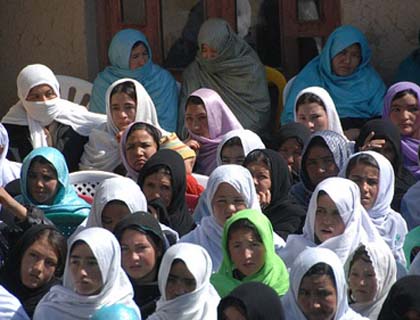In the post-Taliban Afghanistan, "women rights" is the buzzword. Improving the conditions and social standing of women in today's Afghanistan has found devout champions in both the Afghan government and outside in the fledgling Afghan civil society. Numerous institutions have been set up tasked with protecting and reclaiming the infringed rights of Afghan women. The current upsurge in the zeal to uphold the rights of women and the efforts to define a new place for women in various aspects of Afghan life are essentially a new wave of "feminism" in Afghanistan.
Feminism can be defined as sets of diverse social movements with a common aim of improving the overall conditions of women in various aspects of female life, namely in the spheres of family, society, economy, politics and polity, culture and workplace. In the west, feminism has a long history and tradition, stretching as far back as 15th century to the ideas and writings of various thinkers in Europe of Middle Ages. Along with the European Renaissance that ushered in the western civilization, there were early thinkers who took up the cause of improving the lot of deprived European women.
This Middle Ages feminist thought was subtle and sporadic, deprived of any social and institutional organization and therefore many believe it cannot be called feminism in its modern sense. Nonetheless, those Renaissance thinkers' contribution to the history of what we today call feminism has been significant. The modern feminist movement, starting in 19th century, went through transformations and overhauls throughout the 19th and 20th centuries.
The early feminist demands were essentially equality in property rights and granting women the right to vote or suffrage. The new feminism of 1970s and 80s in the west, however, had larger and more ambitious demands: liberation of women from bodily exploitation; freedom in sexuality and choice; equality at workplace and home; taking away sexism from popular culture; end to violence against women and revitalizing the feminist ideals and streams of thought.
In Afghanistan, there has not been an organized and coherent feminist movement until the post-Taliban years in which we are now. It is only in the recent years in which we witness the formation and advancement of a feminist movement spearheaded by enlightened Afghan women and supported by the international community.
The earlier attempts at improving the condition of women, more fair treatment of them and trying to emancipate them from the bonds of tradition wrongly understood as religion were gross failures. King Amanullah and his wife Queen Soraya's failed attempts at promoting education for women and relaxing their strict dress code and exhorting women to do away with the face veil contributed to the king's early downfall. Mohammad Daud Khan, during his prime ministership, supported removal of face veil by women and encouraged greater social and political participation by women.
The 1964 constitution introduced by Zahir Shah for the first time granted suffrage or the right to vote to women of 22 years of age and above and allowed them liberty in pursuing education and work outside the confines of home.
This progressive transition continued in Kabul and major cities and Afghanistan's experiment with gradual education and liberation of women came to deliver promising dividends. Afghanistan's march towards educating and emancipating its women, although limited in scope and reaching mainly the urban elites, was brought to a halt with the Saur revolution in 1978 and the ensuing instability that engulfed the country.
The demands and aims of Afghanistan's new wave of feminism in the post-Taliban era are a combination of what the first and second waves of western feminism of 19th and 20th century endeavored to accomplish. The cornerstone of Afghan women's struggle has been reforming the strictly patriarchal inter-gender relations in a still deeply conservative society and untying many bonds of tradition which, through centuries, have been wrongly understood as religion.
Looking at the theoretical foundations of Afghan feminism, we see that, much like its counterparts in other Muslim societies, Afghan feminism does not strictly follow in the footsteps of western feminism. Afghan feminism, although adopting and using many useful insights, concepts and experiences from western feminism, is predicated within a framework that has roots in Afghan society's Islamic and oriental tradition. Western feminism stresses a religion-free liberation of women; it regards the woman as an individual and emphasizes the self as opposed to the wider units of family and society.
Western feminism places self-gratification of woman ahead of service to society and community. Afghan vision of feminism, on the other hand and much like other feminist movements in other Muslim countries, strives to challenge the ways in which religious authorities interpret religion and the holy texts to subdue and subjugate women. It struggles to define a new and honorable place for the woman and the girl child or the girl bride.
Afghanistan's new experience with feminism is a two-pronged phenomenon. The Afghan State assisted and encouraged by the international community, has given new rights and freedoms to Afghan women, enshrined in the Afghan constitution and the government policies.
The Afghan State declares that it is committed to continuing with the trend and wishes to further institutionalize and strengthen the granted rights and freedoms. On the other end of the spectrum, new breed of Afghan feminists continue to press ahead with their demands and are working to raise awareness among the masses of Afghan women and mobilize them through their empowerment. The stiff opposition to the Shia Personal Status Law, passed in 2009 by the Afghanistan's parliament, clearly showed that the Afghan experience with feminism is only gaining strength.
Economic empowerment and emancipation is a prerequisite for gender liberation. As the urban middle class in Afghanistan expands and more and more families afford to provide education for their daughters, there will be no doubt that this feminist movement would gain traction.

